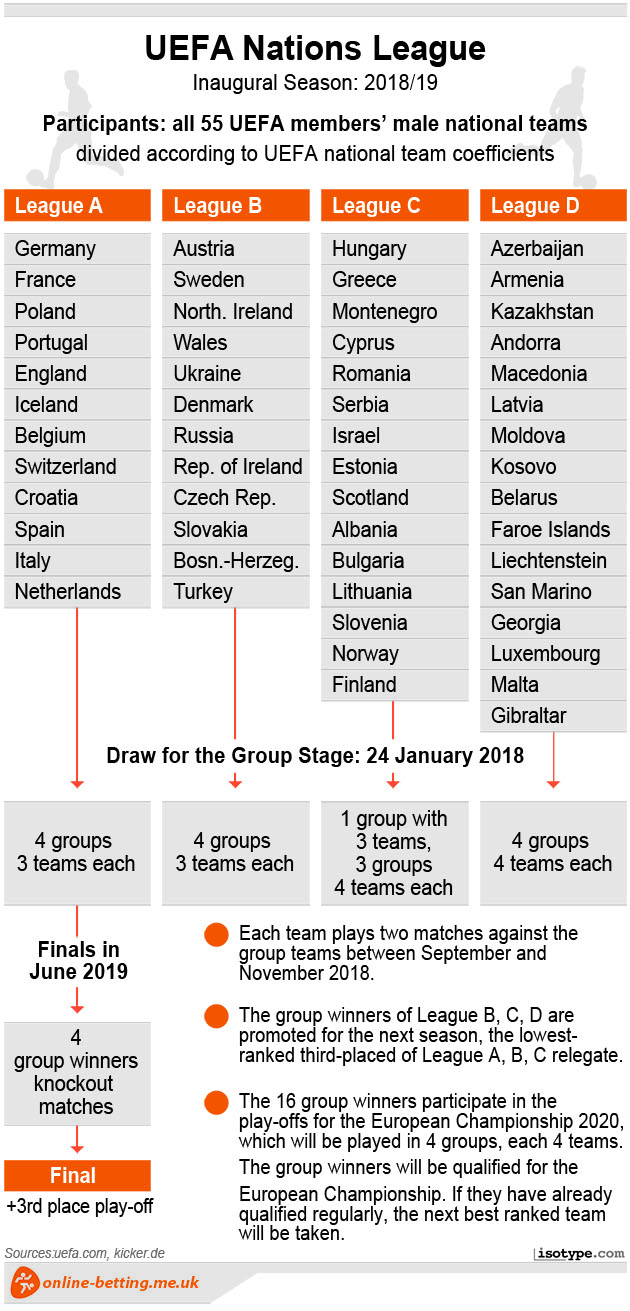You have probably heard about it, but what is the UEFA Nations League exactly? In early November 2017, there were discussions between FIFA and UEFA about how to expand the Nations League on an even bigger scale and that’s before even the first edition of it has been played out. That would all be down the line and is an exciting prospects, but how will the inaugural Nations League, an innovative new format designed to kick pointless international friendly matches to the curb, be playing itself out?
The purpose of the UEFA Nations League
The goal is to try and improve the quality all around of the 55 members of UEFA. There was a desire to bring a bit more of competitive nature into international football. Aside from lopsided qualification groups for the World Cup and European Championships for any nation failing to actually get to those finals, there was nothing else of interest other than friendly matches. Smaller ranked teams in the qualification processes never really stand a chance of getting to Finals. But no longer though, because instead of the friendly matches, teams will be entering into the competitive UEFA Nations League which will fill the international breaks when there are no major tournament qualifying matches happening.
The Format
There are four leagues in the UEFA Nations League. Those are League A, League B, League C and League D. What makes this interesting is that there will be promotion and relegation between the leagues. Within each of the leagues, there are four groups, Group 1, Group 2, Group 3 and Group 4. So, in summary, the setup is this
League A – Group 1, Group 2, Group 3, Group 4
League B – Group 1, Group 2, Group 3, Group 4
League C – Group 1, Group 2, Group 3, Group 4
League D – Group 1, Group 2, Group 3, Group 4
Each of the groups within a league will contain either three or four teams. So at the end of all of the group stage matches, the bottom side in Group 1 in League A will go down to Group 1 in League B. The bottom side of Group 1 in League B will go down to Group 1 in League C and the bottom side of Group 1 in League C drops to the Group 1 in League D. It simply works the other way for promotion between groups.
So nations will only be going up and down the same level Group across the Leagues. So if a team starts in Group 2 in League B for example, they can only get promoted to Group 2 of League A or drop down to Group 2 of League C for the following edition. So teams will be playing to avoid relegation in the groups as well as striving for promotion up the tiers where the better teams are naturally more likely going to be hanging around.
Final Four Competitions
The big prize out of all this is winning the UEFA Nations League. At the end of all of the group stage matches, the top team in each group in League One will move through to a semi final knockout format in a small Final Four competition. The winner of that knockout tournament will be crowned UEFA Nations League Champions.
The Draw
The 55 nations have been split up into Leagues already and spread over the four leagues based on coefficient ranking on October 11th, 2017. League A will host the top ranked sides, League D will host the lowest ranked.
League A: Germany, Portugal, Belgium, Spain, France, England, Switzerland, Italy, Poland, Iceland, Croatia, Netherlands
League B: Austria, Wales, Russia, Slovakia, Sweden, Ukraine, Republic of Ireland, Bosnia and Herzegovina, Northern Ireland, Denmark, Czech Republic, Turkey
League C: Hungary, Romania, Scotland, Slovenia, Greece, Serbia, Albania, Norway, Montenegro, Israel, Bulgaria, Finland, Cyprus, Estonia, Lithuania
League D: Azerbaijan, FYR Macedonia, Belarus, Georgia, Armenia, Latvia, Faroe Islands, Luxembourg, Kazakhstan, Moldova, Liechtenstein, Malta, Andorra, Kosovo, San Marino, Gibraltar
There will be a draw in January 2018 to decide which teams in each league go into the respective groups.
When will the matches be played
The inaugural edition of the UEFA Nations League will be held in 2018, across six match days during the regular “double headers” of international breaks that crop up in September, October and November. So punters will have no more of those boring international friendly matches, instead, there will be actual competitive tests for the nations, again, all designed to bring the quality of the UEFA members up. The Final Four competition will be scheduled in for June 2019.
UEFA European Championship impact
So that is the basic setup for the new UEFA Nations League, but there is another part to all of this as well because it will have a bearing on UEFA Euro qualifying as well. The European Qualifiers start in March 2019 and there will be two match days in each of March, June, September, October and November 2019. So this has all gotten much more streamlined. There will five groups of five teams and five groups of six teams and the winners and runners up of all ten groups will automatically book a spot at Euro 2020.
But that leaves four places open and this is where the UEFA Nations League comes back into play.
Each of the four Nations Leagues (A, B, C & D) will each have four play-off positions towards the UEFA European Championship qualifying in them. The first priority will be each group winner within a league. If a winner of a group has already qualified for Euro 2020 then the play-off position will go to the next best ranked team of the league.
So far example:
League B Final Standings:
Group 1: Wales, Sweden, Slovakia
Group 2: Bosnia, Northern Ireland, Turkey
Group 3: Russia, Denmark, Czech Republic
Group 4: Austria, Ukraine, Ireland
The four Euro 2020 qualifying play off spots from Group B would go to Wales, Bosnia, Russia and Austria. But let’s say that Bosnia, Northern Ireland and Austria qualified automatically for the final for the European Championship through the regular qualification format. The four play off spots from League B would then be Wales, Turkey, Russia and the Ukraine.
So each Nations League league will have its own route to the Euro 2020 play-offs. Each League will then feature two semi finals and a final between its qualified teams and the winners of each of the four finals (from League A, League B, League C and League D) will fill the final four spots at the European Championship Finals.
The Benefits of the Euro Play Offs
It does mean that a team from League D, which will house the lowest ranked sides in the Confederation will be making its way to the European Championships, so the format opens things up a little more to the lower ranked nations. It basically gives the middle and lower ranked nations an extra way to get to the European Championship finals and produces another competitive edge factor for teams to perform well in the Nations League and not take it too lightly. It also, of course, gives the smaller nations incentive to climb up the Leagues in the Nations League to test themselves against the better ranked sides.
Not totally the end of friendlies
While this Nations League will cut out some of those dull friendlies matches, because some of the groups only three teams in them, it leaves a space open for fitting in friendlies against sides from around the world still. So friendly internationals involving European nations will be cut down as a whole, but they will still be there, especially still in preparations ahead of major tournaments.











